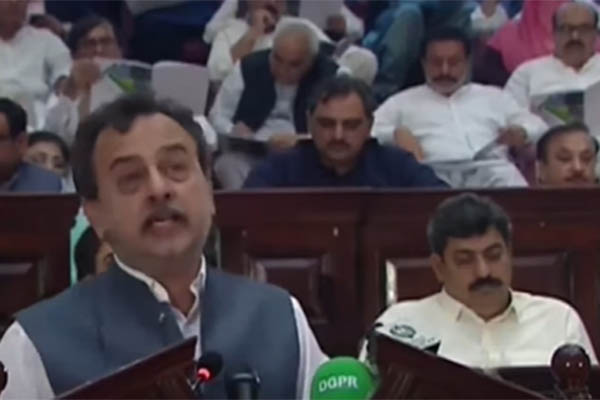
Screengrab of the budget speech for Punjab
The Pakistan Muslim League (Nawaz)-led government in Punjab on Wednesday unveiled a Rs. 3.2 trillion, with acting finance minister Awais Leghari saying it aimed at boosting development spending, retaining tax cuts and discounts, and increasing subsidies to provide relief to citizens.
According to Leghari’s speech, the budget has allocated Rs. 685 billion to development spending, and has also proposed increasing development and non-development expenditure to Rs. 485.26 billion and Rs. 470 billion, respectively. The provincial government also expects to receive Rs. 2.02 trillion from the federal divisible pool under the National Finance Commission (NFC) Award.
The budget for fiscal year 2022-23 has estimated collecting Rs. 337 billion as provincial tax; Rs. 163.5 billion as provincial non-tax; Rs. 705.1 billion as capital tax; and Rs. 61.6 billion as foreign project assistance. This is in contrast to total expenses of Rs. 3.1 trillion, making it a surplus budget with Rs. 125 billion. The expense includes Rs. 685 billion for the Annual Development Program; Rs. 1.7 trillion as current revenue and Rs. 704.5 billion as current capital.
“The increased expenditure of Rs. 485.26 billion includes Rs. 428.56 billion and Rs. 56.7 billion for non-development and development expenses, respectively. The overall education budget outlay will include Rs. 421.6 billion for school education, Rs. 59.07 billion for higher education, Rs. 1.52 billion for special education and Rs. 3.59 billion for literacy and non-formal education,” provincial minister Awais Leghari said in his budget speech.
He said Rs. 470 billion had been proposed for the health sector, adding that 40 percent had been allocated to social services from the ADP; 24 percent to infrastructure; 6 percent to production; and 2 percent to the services sector.
The budget, similar to the allocations proposed by the federal and provincial governments, has proposed a 15 percent increase in the salary of public sector employees, and 5 percent raise in the pensions of retired officials. Meanwhile, Rs. 109.1 billion has been allocated for foreign-funded project; Rs. 1.35 billion for minority development; Rs. 1.5 billion for the provision of laptops to students; and Rs. 528 billion has been proposed for local governments. “We are reviving all projects that were either stopped or slowed down by the PTI government under politically ulterior motives,” announced Leghari. “The projects we are reviving include the Pakistan Kidney and Liver Institute, for which we are proposing Rs. 5 billion,” he said.
Among the subsidies announced by the government—against a total allocation of Rs. 190.6 billion—are a continuation of the Rs. 200 billion subsidy on flour that is already underway; Rs. 5 billion for ghee; Rs. 2 billion for the Ramzan Package; Rs. 17.32 billion for agriculture; Rs. 17.89 billion for transport; Rs. 0.44 billion for e-credit facility for small farmers; Rs. 39.93 billion for free medicines; Rs. 2 billion for drought; and Rs. 6 billion for environmental/climate change challenges.
In a bid to curtail government spending, the budget has proposed a ban on the purchase of new vehicles and air conditioners exceeding an aggregate amount of Rs. 5 million, as well as bans on medical treatment abroad on state expense; air travel through government funding; holding workshops/seminars out of public funds; and upgrading of official posts.
The government has also proposed various tax reforms, including harmonization of the Punjab Revenue Authority procedures with Federal Board of Revenue and similar authorities; revision in e-auction policy for vehicle registration numbers; enhancement in rate of stamp duty from 1 to 2 percent in urban areas; and enhancement of rates of luxury houses with effect from July 1.
